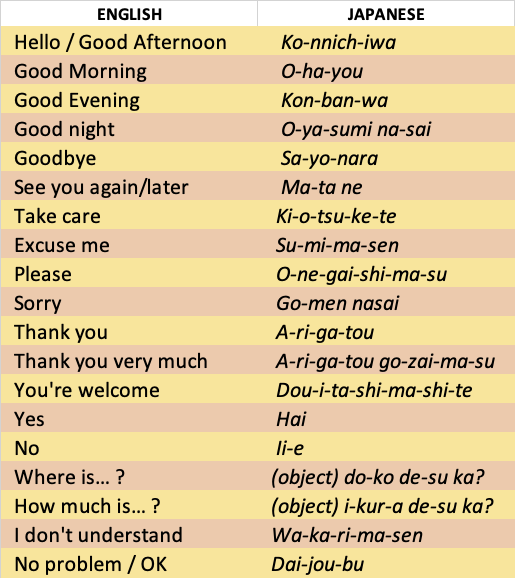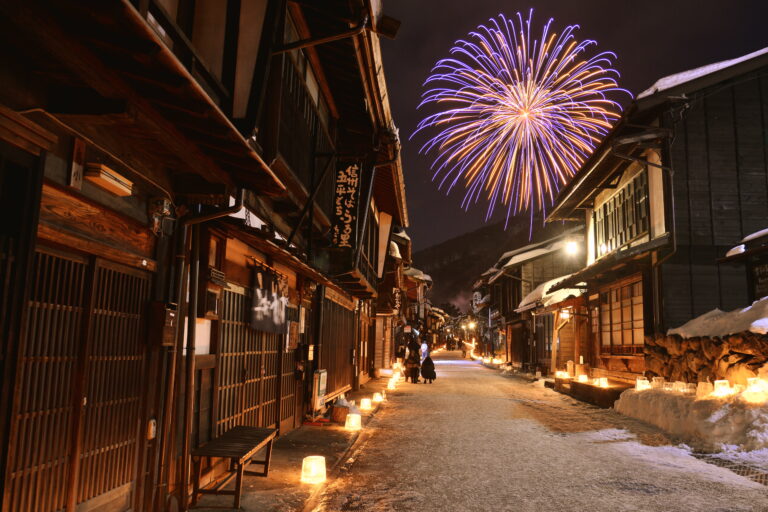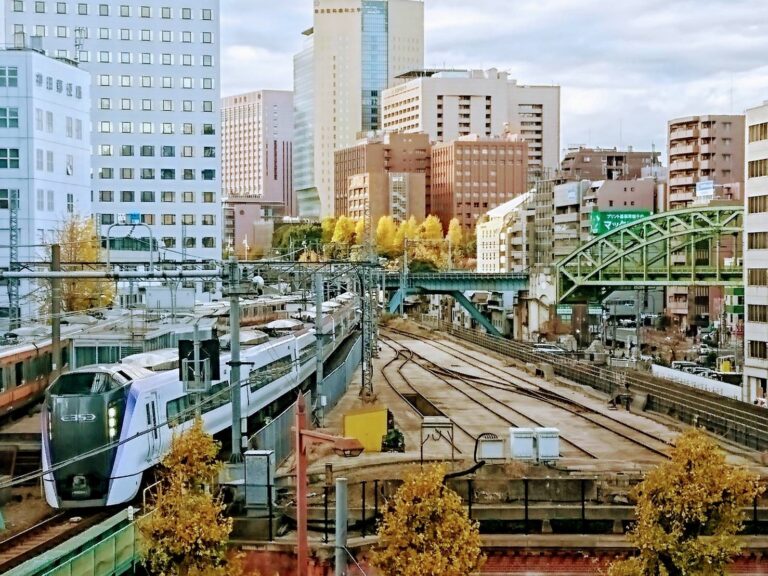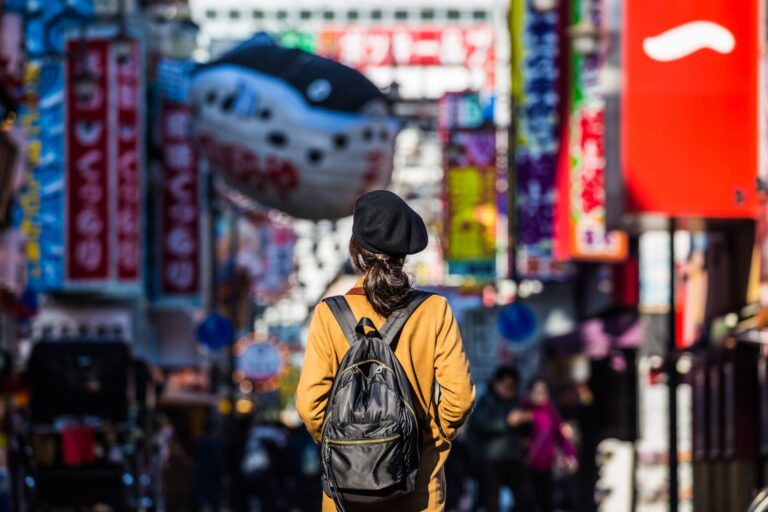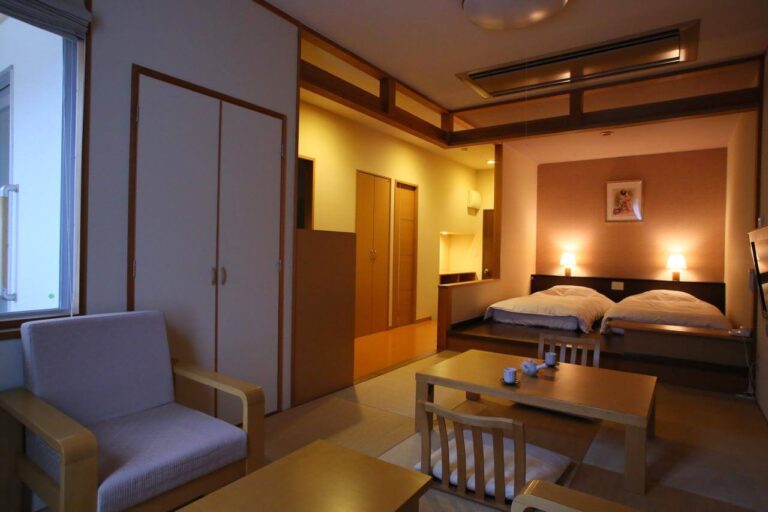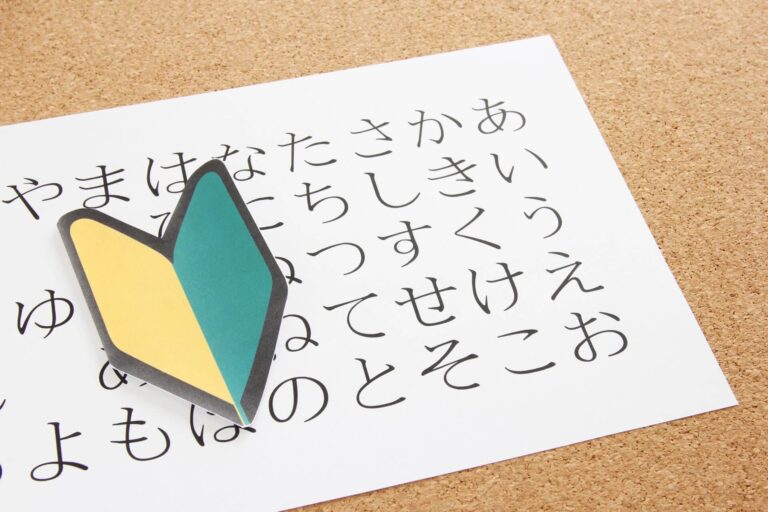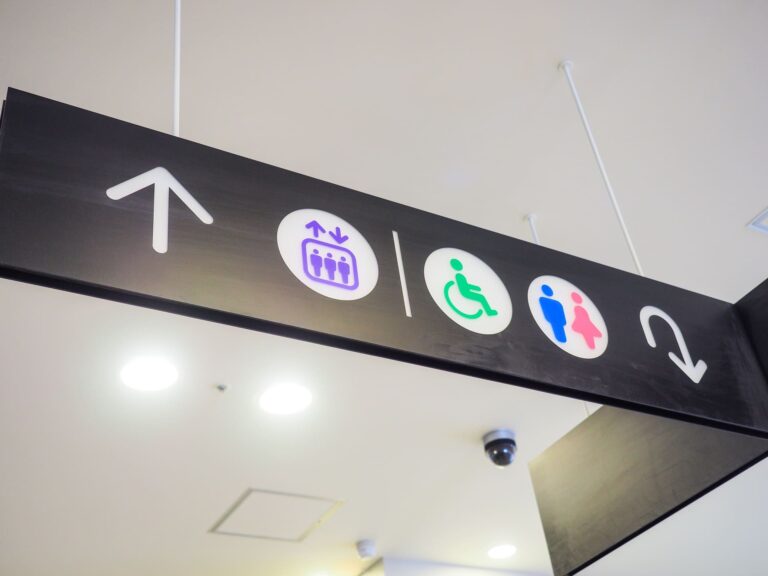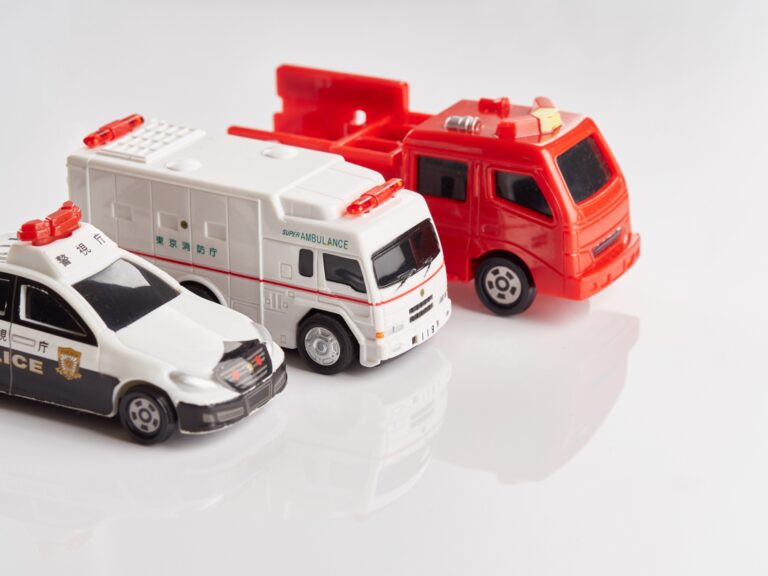Getting-On in Japan: Language & Etiquette
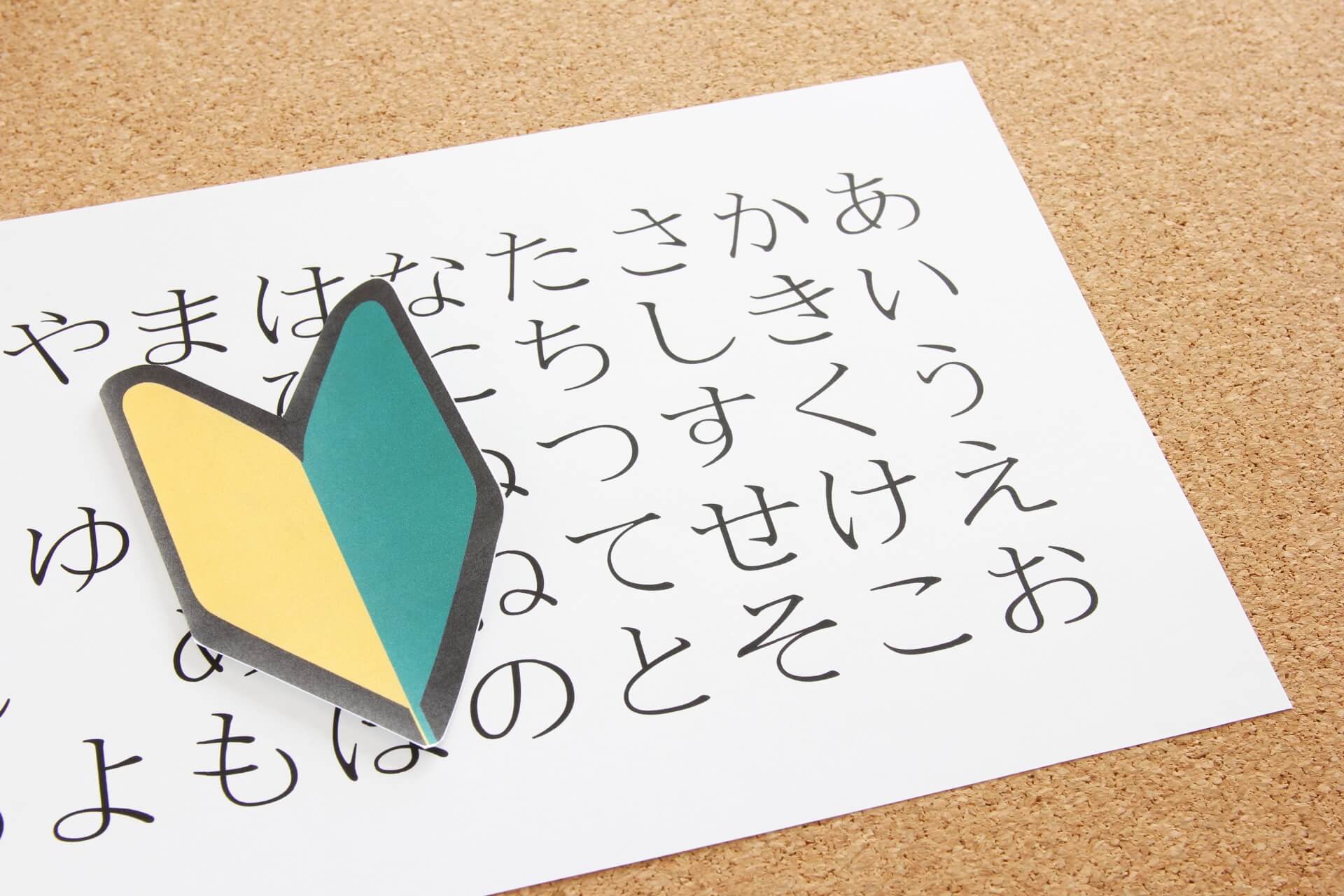
International visitors love many things about Japan. Safe and easy to travel around and endlessly interesting, it is in many ways an ideal travel destination.
1 / Japanese Language: Learning the Basics
2 / Japanese Language: Useful Apps
3 / English & Other Foreign Languages
4 / General Etiquette: Do’s & Don’ts While in Japan
5 / Onsen Etiquette: Do’s & Don’ts
For further essential travel information, see our ‘Plan Your Visit’ main page.
1 / JAPANESE LANGUAGE: LEARNING THE BASICS
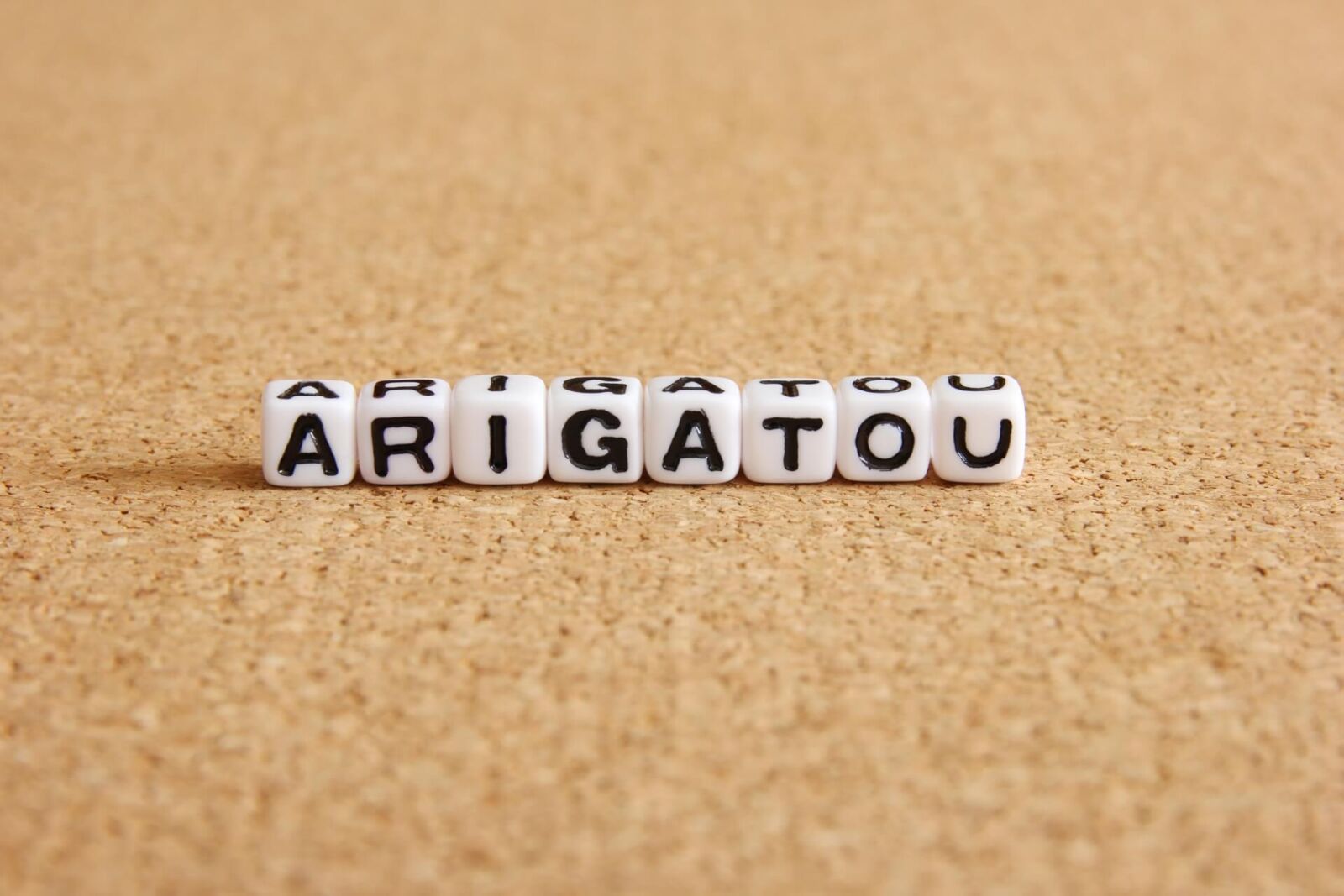
While all Japanese have to learn English at school and often have much better English ability than they might let on – see below for why that’s the case – one of the great pleasures of traveling in any country is engaging in the local language – and this is certainly the case while in Japan! When heading this way it pays to learn and use a little Japanese and the best way to do so is by dispelling a commonly held misconception that Japanese is a difficult language to learn. It’s true that learning Japanese to an advanced level is challenging – most notably in learning to read and write fluently – however when getting started, the basics are actually pretty easy. The following points are often over-looked about the Japanese language:
— Japanese pronunciation is pretty straight-forward, especially for English-speakers
— Japanese does not have any tone (a big reason pronunciation is pretty straightforward)
— Japanese sentence structure is pretty easy and doesn’t change = SUBJECT + OBJECT + VERB. When getting started, you are usually talking about yourself or want you need so you can drop the subject and just put the object and verb together. You can even drop the particle words – the equivalent of ‘to’, ‘for’, ‘in’, etc. – and still make sense. So it’s actually quite easy to get your point across
— Japanese are very appreciate if you make the effort to even speak a little. They are also very encouraging and patient and will try hard to understand what you are saying
— Japanese is a nice language to speak. Many people remark that it sounds nice and is fun to try!
English is in common use in Japan with Chinese and Korean also becoming more common meaning that you can certainly get around without using Japanese. This is most true in the big cities and in areas frequented by foreign visitors. But as you move outside of the cities, foreign languages will quickly dry-up. To get the most out of your travels, learning some basic can really add to your experience here.
Where to start?
The following basic words are easy to learn and can be used immediately upon arriving in the Japan. It’s amazing what a difference knowing and using just these basic words like make to you time here:
Japan’s national broadcaster NHK provides useful basic Japanese videos for travellers in English, Chinese, Bahasa, Thai and Vietnamese and provide this extensive ‘Tourist’s Language Handbook’ free of charge.
‘Daijoubu desu‘
One of the most simple yet useful words in Japanese, ‘daijoubu’ can be used in lots of situations to convey that you are ok, understand, or do or don’t want something. ‘Daijoubu’ or it’s polite form, ‘daijobu desu’ translate as ‘OK’ , ‘I’m OK or more broadly, ‘no problem’. It can cover all manner of situations from simply confirming that you understand or are ok with something, expressing that everything is fine – for example, if some apologises to you and you want to convey that everything is fine i.e. ‘daijoubu desu’ = no problem – or if you want to say you’re ok and you don’t need something i.e. if you want to avoid be given endless plastic bags just shake your head and say ‘daijoubu desu’ = I’m ok, I don’t need it. It’s all about the context and it can be used to lots of situations making it one of the most useful words to know while travelling around.
Loan words
Something that might surprise you is that Japanese takes a lot of words from foreign languages including English, German, Italian, French and many others. This provides visitors with something of a language hack in that the names of many daily items are taken from a foreign language, most notably English. For example, table in Japanese is ‘ta-be-ru’, knife is ‘nai-fu’, salad is ‘sa-la-da’ and so on. Hotel is ‘ho-te-ru’, taxi is ‘ta-ku-shi’ and bus is ‘ba-su’ (unfortunately this doesn’t extend to train which is ‘densha’). So while it might sound like a joke, if you’re asking for something and struggling to be understood, break the word-up and put a ‘a’, ‘o’ or ‘u’ at the end of the word and you may well get it right! A useful tip for receiving your ‘bi-ru’ faster than you’ll receive our beer.
2 / JAPANESE LANGUAGE: USEFULS APPS & WEBSITES
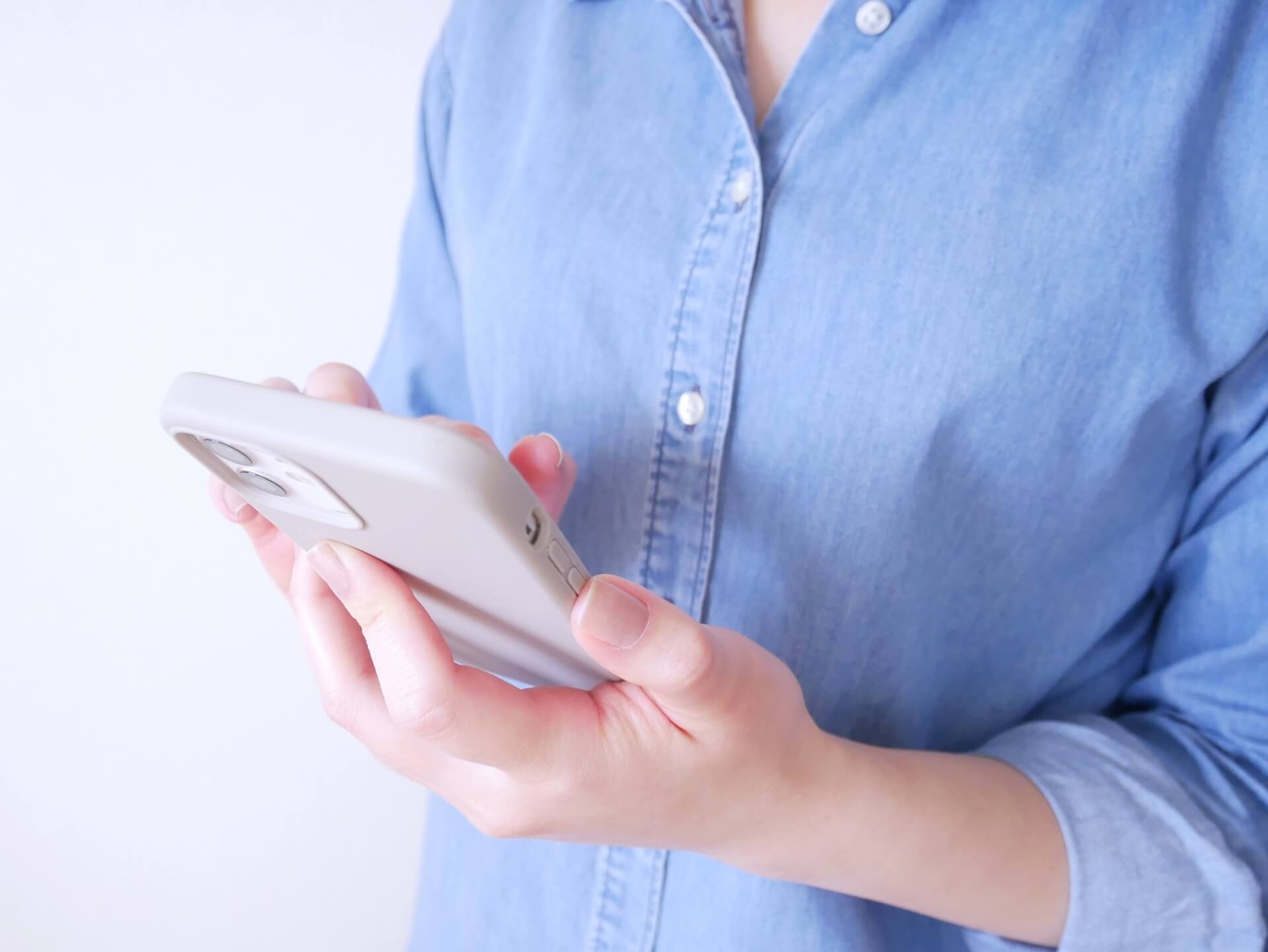
Whether you speak some Japanese or nothing at all, arming yourself with a language app on your phone is always recommended. This will prove especially helpful when dealing with written Japanese, which is notably harder to master than spoken language.
The most obvious place to start is Google Translate. Available on both iOS and Android the app translates spoken and written language. You can type English or Japanese into your phone for a translation or most helpfully, use the phone’s microphone to translate speech in real-time. The app also has the ability to read and translate text using your phone’s camera, particularly useful for understanding menus! Available for download for free, Google Translate is a good place to start.
While Google Translate is terrific for language on the go, we also recommend DeepL Translator. We find that it’s translation is more accurate and nuanced the Google Translate and is particularly good when handling longer text including complicated clauses and subclauses i.e. booking confirmations with terms and conditions. The free version of DeepL doesn’t have the same range of features as Google Translate but if you’re after accuracy in translation of longer text it really is excellent.
3 / ENGLISH & OTHER FOREIGN LANGUAGES

There is something of a misconception that most Japanese can’t speak English. While it is true that Japanese (in general) don’t have as much confidence speaking English as many other nationalities, it should not be mistaken with an inability to do so. English is a compulsory language for all Japanese throughout their schooling. Despite this, many visitors to Japan are surprised by the apparent lack of English and other foreign languages spoken here. First impressions are however a little misleading.
While Japanese learn English for the duration of their schooling, their tuition has a strong focus on reading and writing. Many Japanese read and write English at a high level but when it comes to speaking, they can lack confidence. This is likely the result of an education system that does not prioritise speaking nor instill students with the confidence to try.
This should however not be mistaken with an inability to speak English. Even if they are not confident speaking English, many Japanese have a good understanding and adequate vocabulary to comprehend what you are saying as long as you speak clearly, slowly and politely. Remember, Japanese borrows a lot of words from English and other languages – ‘loan words’ as described above – so you can often get your point across by just slowing down and using plain language.
When it comes to other foreign languages, Chinese and Korean and the next most common. Signs and announcements in areas frequented by tourists are increasingly available in Chinese and Korean – a reflection of the fact that they represent a large section of the inbound tourism industry with large communities living here. The average Japanese will not speak either language however, nor are they likely to speak other Asian or European languages. Need to find an English or other foreign language service? See our ‘Getting Assistance in Japan’ page for suggestions.
4 / GENERAL ETIQUETTE: DO’S & DON’TS WHILE IN JAPAN
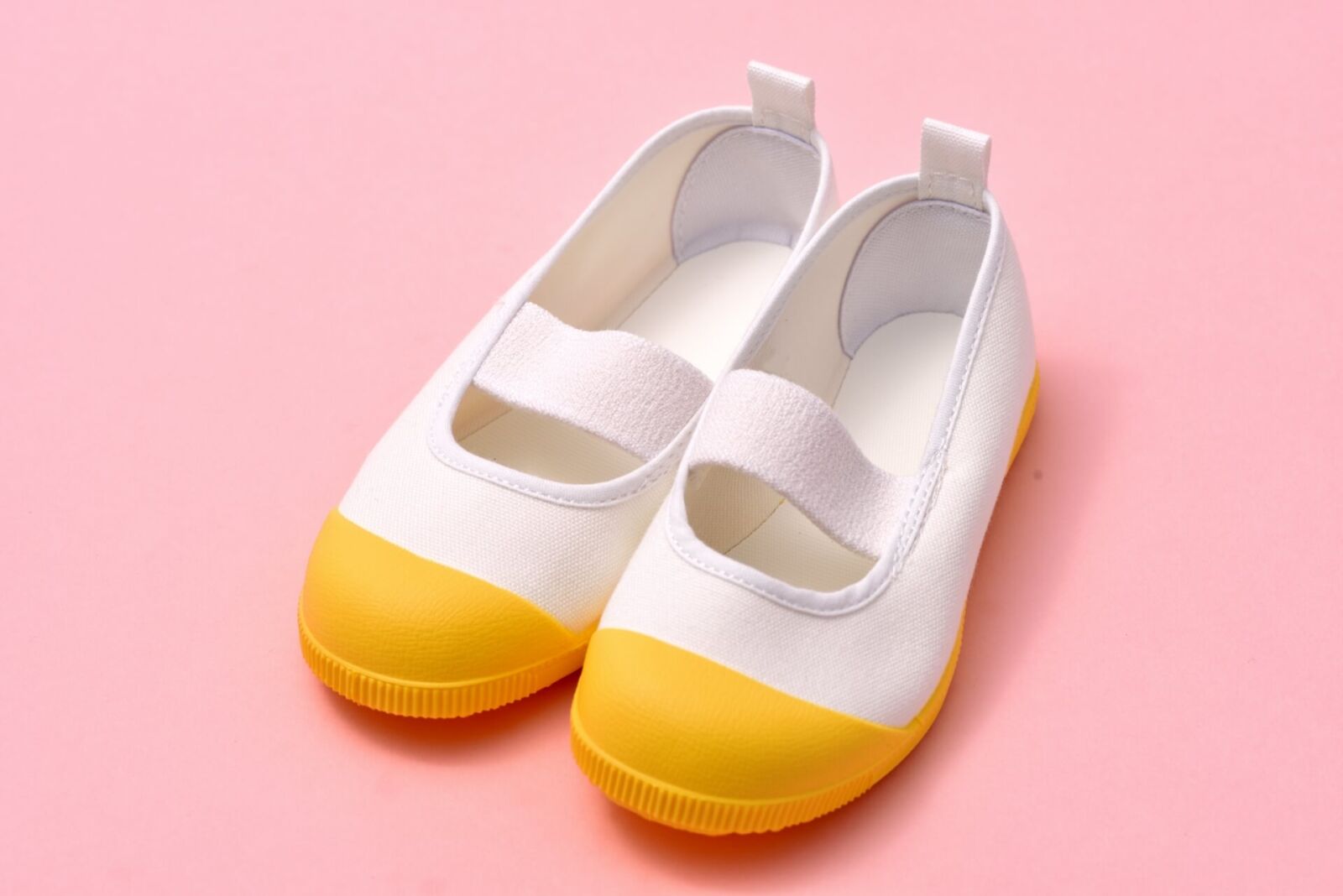
Another big misconception about Japan is all the cultural rules and that it’s easy to offend people. It’s true that there lots of rules for Japanese to abide by, they know that visitors to Japan are not aware of most of them and do not expect you to follow them. You are not Japanese therefore all the rules and complex etiquette you might have read about really doesn’t apply to you and rest assured, even if you get something wrong Japanese are very courteous and forgiving. With that said, let’s run through some of the etiquette including basic do’s and don’ts starting with the ones you really should try to follow:
Leave your shoes at the door: Japanese do not wear their shoes inside their home. When entering someone’s home make sure to take your shoes off at the entrance. They will most likely then offer you slippers to wear. In terms of public spaces in Japan, some restaurants, stores and accommodation also follow this norm. It will usually be clear if you are required to take your shoes-off as there will likely by a shoe box of shelving, other shoes and slippers at the entrance. If in doubt, just ask and you’ll be told.
Definitely no shoes on the ‘tatami’: many Japanese homes, businesses and hotels retain the tradition of using ‘tatami’ (straw-matting). If dirt gets into tatami it can be very hard to clean and in the end may need to be replaced. Under no circumstances should you wear shoes when stepping onto tatami. While there’s always a degree of forgiveness if you wear shoes into a home or business you should not, that is easily cleaned and excused, however should you step onto tatami-flooring wearing shoes, expect a stern reaction. This is one rule not to break.
Be mindful of noise: Japanese are very considerate of others when it comes to noise, especially on trains, buses and while in public spaces. Follow their lead and be quiet in these areas especially while on trains as many people are tired and sleeping. Do not speak on the phone while on trains and buses unless completely necessary – and if you do, try to move away from people and speak quietly – and don’t speak loudly to people you are traveling with.
Personal space: Japanese are also very mindful of personal space and not encroaching on others. Make sure to allow people as much space as possible and don’t allow your personal items including luggage to impede people. Even on crowded trains Japanese will try to take-up as little room as possible. Not always easy, the important thing is that you are seen to try and that you move aside to let people pass.
Physical contact & displays of affection: travellers to Japan will quickly notice the lack of physical contact here. Traditionally, Japanese do not shake hands or touch each other, unless they are family or friends. Refrain from physical contact on people you do not know and when it comes to your loved ones, it’s best from to refrain from obvious displays of affection. This applies mostly to couples. Japanese traditionally do not show physical affection in public and the sight of a couple doing so, can be very uncomfortable for older Japanese. Things are changing with many younger couples now affectionate in public but best to follow tradition if you want to get along.
Cleaning-up after yourself: Japanese have the rather fantastic habit of cleaning-up after themselves and never leaving their surroundings untidy. Make sure to do the same while here. If that means carrying you rubbish with you until you can find a bin, so be it. It’s exactly what Japanese do. Many restaurants also expect you to remove your tray, plates, cutlery and rubbish to a designated spot at the end of your meal. Just look around and see what others are doing and follow their lead.
That’s it! Those are the rules that you really should try to follow and if you do, you are unlikely to have any problem while here. But you’re correct in thinking that Japan has lots and lots of rules and etiquette! You’re not expected to know it all and will certainly be forgiven for breaking these rules, but they are also worth making note of (including a couple of things that don’t happen here):
Bathing: whether at home using the family bath or in public at ‘onsen’ (hot springs), shared bathing is common in Japan. As a traveller in Japan, you are most likely to encounter this a traditional guesthouses or public hot springs. For onsen etiquette including do’s and don’ts see below. Should you be offered a bath in a small guesthouses or family home, the water will typically be shared by everyone. Ensure that you shower and thoroughly wash yourself before entering the water and clean-up after yourself for the next person.
Bowing: traditionally Japanese bow as a formal greeting and sign of respect. The longer and deeper the bow, the more meaning that is carried by it – whether that be gratitude, apology and everything in-between. So pocket that handshake and polish-up your bowing.
Business cards: called ‘meishi’ in Japanese, business cards are essential to getting along in Japan. If you’re here for business or think the possibility might arise during your travel, it pays to have your meishi on standby. There is a whole ritual for Japanese when exchanging cards but as a foreigner, you’re not expected to know. The important thing is to offer your card using both hands – holding the card at its corners – and accepting a card in the same manner. It also looks good to study the details of the card before placing in down carefully.
Chopsticks: it pays to polish-up your chopstick skills in preparation for your visit. Called ‘hashi’ or ‘o-hashi’ in Japanese, chopsticks are standard and while Western cutlery is also available, we recommend at least trying your hand at chopsticks. When using them, don’t use them to point or pass things to others. Also don’t stand them up in your dish and especially do stick them into/stand them in rice. Doing so is associated with funeral rituals and while you’ll be excused for not knowing, it will definitely get some dirty looks.
Conflict & disputes: in a culture that values harmony above most other things, it comes as no surprise that most Japanese go out of their way to avoid conflict or public disputes. While this attitude extends to international visitors and it is likely that you will enjoy your time here with no trouble at all, should something arise leading to a dispute choose your approach and words carefully. Be respectful and do not raise your voice. Even if you are certain that you are correct, don’t push the person into a position that leads to public embarrassment and do not raise your voice. Even if someone doesn’t pay you the same respect, if you choose to do so it will most likely only escalate the situation. Stay calm and polite and when possible, just let it go.
Disposing of rubbish: visitors to Japan always notice the lack of rubbish bins available. This can be annoying to begin with but you quickly get used to it and realise that Japanese will often carry their rubbish with them to be disposed of at home or in the office. Carry a zip-lock plastic bag in which you can keep your rubbish until you find a bin. When you do, please also follow the instructions and dispose of your rubbish in the appropriate bin. This may seem like a small thing but if you don’t, your obliging someone else to go through the bin to separate it for you.
Eating & drinking in public: it’s becoming more common to see Japanese walking with a coffee however traditionally, eating and drinking while you walk has always been frowned upon. There exceptions such popular attractions or during ‘hanami’ (cherry blossom-viewing) season when people often wander with drink and snacks, however for the most part it’s best to avoid eating while you walk.
Escalators: when standing on escalators always stand single file and on the left*. Leave the righthand-side of the escalator for people to pass you on, noting that being on-time in Japan means being early and many people will be rushing past you on their way to work, meetings and appointments.
*Confusingly, in Osaka you are expected to stand on the righthand-side and people pass on the left.
Getting-on & off trains: Japanese love to queue and no place more so than at train stations. People from queues either side of where the train doors will be positioned once the train arrives. They are mindful not to impede people getting-off first before moving onto the train. Don’t cut the queue and make sure to let everyone off before getting on.
Gift-giving: is a big and endless part of Japanese culture. As a foreign visitor your outside of this system but should you be invited to a home, it’s a good idea to take something. It doesn’t have to be fancy. It’s the effort that counts. Supermarkets and conveniences stores are geared-up for this with simple gifts such as food and fruit always being a safe bet.
Holding doors for others: does not happen. While it’s common in many other countries, it isn’t a custom in Japan so be prepared for the person if front of you to allow the door to fly straight back at you. If you’re from a cultured in which holding the door is engrained in you, this can be annoying but in a land of sliding doors, the custom just never got a chance to establish itself.
Lining-up: Japanese love to line-up and it’s rare to see anyone cut a queue. It’s a very nice custom and one that Japanese will appreciate if you follow.
Names: in Japan, family name comes first, given name comes second and there are no middle names. Japanese understand that in the West, the order is reversed however can get confused by middle names and sometimes mistake middle names for a persons’ family or given name. But typically you’ll be referred to your family name plus the honorific of ‘san’. You might also like to use this for Japanese – family name + ‘san’ – until you are familiar or they tell you otherwise. You don’t use ‘san’ to refer to yourself.
Smoking in public: smoking rates in Japan remain notably higher than in many other countries with smoking indoors, including restaurants and bars, still permitted. This is slowly changing with more-and-more venues now banning it but be prepared to encounter more smoking here than you may be used to. Smoking in public especially while walking is however frowned upon. Most cities and towns prohibit smoking on the street and provide designated smoking areas.
Sniffing/blowing your nose: blowing your nose into a handkerchief is considered bad manners. Japanese will choose to sniff rather than do so and while for many foreign visitors this will be equally unpleasantly, it’s considered normal and the best way to go.
Tattoos: while things are slowly changing, tattoos are nowhere near as common in Japan as they are in many other countries. Indeed, for Japanese to have tattoos remains largely frowned upon and should they have a visible tattoo, they are making a big decision in terms of the work and lifestyle they can have. There are reasons for this. In the past and for many years, tattoos were used to brand criminals in Japan. The patterns and symbols used would reflect the nature and place of the crime and therefore, in the eyes of law-abiding citizens, tattoos identified criminal and dangerous individuals. From the late-18th century onward, criminals embraced this practice as their own and began to use elaborate decorative patterns as a mark of pride. As a result, the practice of tattooing was outlawed in Japan and only practiced by the criminal underground, most notoriously, the yakuza (Japanese mafia). Most Japanese realise that for foreigners, tattoos do not have the same stigma however they may still be uncomfortable with them. This will be most apparent at ‘onsen’ (hot springs) which often deny entry to anyone with a tattoo. Should you have a tattoo and be denied entry to an onsen or other place of business, take it gracefully and move on. The owner might actually have no problem with it but be thinking of their regular customers who, especially if elderly, may not be comfortable, complain and stop using their business. For younger Japanese, the stigma is fading so look around and sooner or later you’ll find an onsen with an open policy.
Tipping: tipping is not typical or expected in Japan. Japanese do not expect to receive a tip and may be uncomfortable if you offer them one. This is simply a reflection that there is no tradition of tipping in Japanese culture and many people don’t like to be singled-out even if it’s for a positive reason. However to say that tipping is rude is also not accurate. It’s just not typical. If you’d like to leave a tip, for example at a restaurant, do so when leaving and offer it as a tip to the restaurant/all staff rather than an individual.
5 / ONSEN ETIQUETTE: DO’S & DON’TS
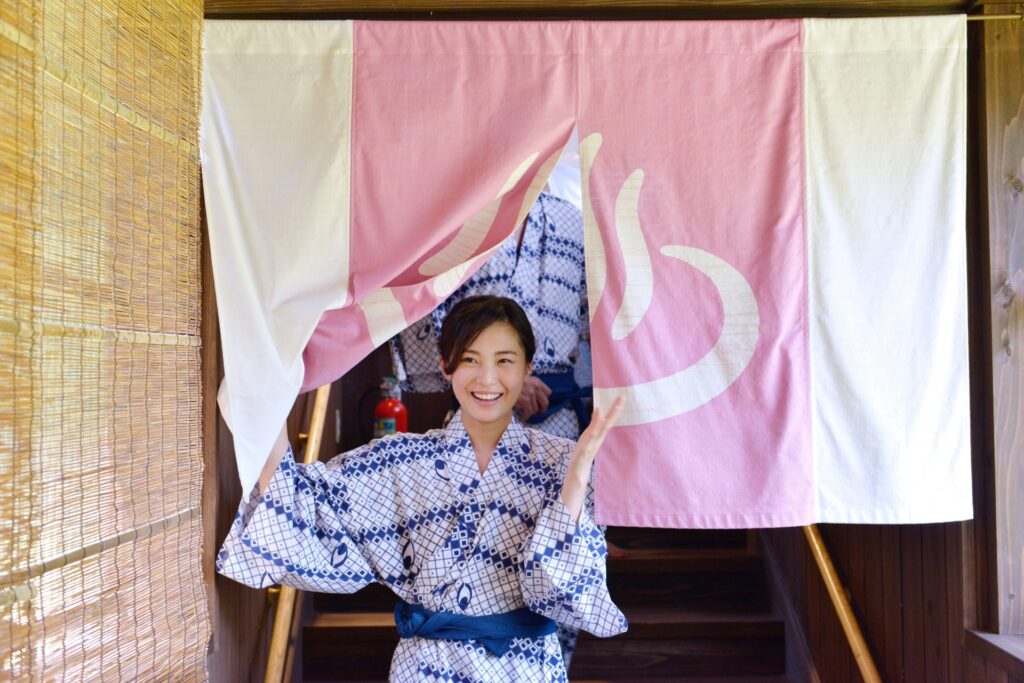
Known as ‘onsen’ in Japan, natural hot springs are dotted throughout the country and offer one of the most relaxing and quintessentially ‘Japanese’ experiences while here. For many Japanese, onsen is a regular (if not daily) activity, something they engage in from infancy and throughout their lives. Yet for international visitors, entering and using an onsen can be intimidating, especially on their first visit. Rest assured it’s nothing to worry about. While there is certainly an onsen etiquette, it is not as strict as many imagine rather just a few basic rules to ensure the comfort and enjoyment of guests and maintain the cleanliness of the hot spring.
Many onsen refuse entry to guests with tattoos. As noted above, there are historical reasons for this but attitudes are also changing. Guests with tattoos should always check first before entering to avoid any awkward interactions once in the onsen. We hope the following STEP-BY-STEP INSTRUCTIONS are of assistance:
– most importantly, start by entering the correct onsen! While many will use the English words for men’s and women’s, others may only display the ‘kanji’ character. For men, look for 男 (‘otoko’ meaning male) and for women, look for 女 (‘onna’ meaning female)

– when passing from the hotel into the onsen, take off your shoes and leave them at the entrance or inside a shoebox
– there will usually be a change room with lockers. Remove all clothes – yes, all clothes – and place your clothing and large towel in a locker or basket
– you are now ready to enter the onsen. The only things you can take with you is your small towel and locker key (if required).
– it’s now time to wash. Sit on a stool and thoroughly wash your body and if you want, also wash your hair. Guests with long hair should tie it so it doesn’t enter the water
– wash bowls are usually on-hand to allow you to throw water over yourself. Once done, make sure you are clean of any soap and place everything back as you found it
– you can now enter the bath and ensure nothing above your neck is below the water surface
– your towel should not enter the water but instead can be placed to the side of the bath or atop of your head, as long as it’s out of the water
– when leaving the onsen, some people choose to wash themselves down again with the shower – especially if the water is acidic or sulphuric – but there’s no requirement to do so
– as you leave and re-enter the change room, ensure you wipe yourself down as best as possible to avoid creating a mess in the change room.
This will quickly become second-nature and you’ll be able to relax fully into the experience.
To make it easier, just follow these SIMPLE RULES and you’ll be fine:
– never wash yourself in the onsen water
– do not wear any clothing into the onsen water (unless you are told it’s acceptable)
– do not put anything in the onsen water
– do not splash or cause a disturbance
– don’t speak loudly or yell
– never take alcohol into the onsen (unless you are told it’s acceptable)
For more information including tips and advice about where to find the best hot springs in Central Japan, see our ‘Onsen in Japan’ main page.



